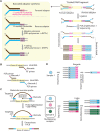A systematic review of the barcoding strategy that contributes to COVID-19 diagnostics at a population level
- PMID: 37496777
- PMCID: PMC10366608
- DOI: 10.3389/fmolb.2023.1141534
A systematic review of the barcoding strategy that contributes to COVID-19 diagnostics at a population level
Abstract
The outbreak of SARS-CoV-2 has made us more alert to the importance of viral diagnostics at a population level to rapidly control the spread of the disease. The critical question would be how to scale up testing capacity and perform a diagnostic test in a high-throughput manner with robust results and affordable costs. Here, the latest 26 articles using barcoding technology for COVID-19 diagnostics and biologically-relevant studies are reviewed. Barcodes are molecular tags, that allow proceeding an array of samples at once. To date, barcoding technology followed by high-throughput sequencing has been made for molecular diagnostics for SARS-CoV-2 infections because it can synchronously analyze up to tens of thousands of clinical samples within a short diagnostic time. Essentially, this technology can also be used together with different biotechnologies, allowing for investigation with resolution of single molecules. In this Mini-Review, I first explain the general principle of the barcoding strategy and then put forward recent studies using this technology to accomplish COVID-19 diagnostics and basic research. In the meantime, I provide the viewpoint to improve the current COVID-19 diagnostic strategy with potential solutions. Finally, and importantly, two practical ideas about how barcodes can be further applied in studying SARS-CoV-2 to accelerate our understanding of this virus are proposed.
Keywords: COVID-19; COVID-19 diagnostics; SARS-CoV-2; barcoding technology; population diagnostics.
Copyright © 2023 Chen.
Conflict of interest statement
The author declares that the research was conducted in the absence of any commercial or financial relationships that could be construed as a potential conflict of interest.
Figures

Similar articles
-
Effectiveness and cost-effectiveness of four different strategies for SARS-CoV-2 surveillance in the general population (CoV-Surv Study): a structured summary of a study protocol for a cluster-randomised, two-factorial controlled trial.Trials. 2021 Jan 8;22(1):39. doi: 10.1186/s13063-020-04982-z. Trials. 2021. PMID: 33419461 Free PMC article.
-
High throughput SARS-CoV-2 variant analysis using molecular barcodes coupled with next generation sequencing.PLoS One. 2022 Jun 21;17(6):e0253404. doi: 10.1371/journal.pone.0253404. eCollection 2022. PLoS One. 2022. PMID: 35727806 Free PMC article.
-
Molecular Diagnostic Tools for the Detection of SARS-CoV-2.Int Rev Immunol. 2021;40(1-2):143-156. doi: 10.1080/08830185.2020.1871477. Epub 2021 Jan 13. Int Rev Immunol. 2021. PMID: 33439059 Review.
-
Multi-tiered screening and diagnosis strategy for COVID-19: a model for sustainable testing capacity in response to pandemic.Ann Med. 2020 Aug;52(5):207-214. doi: 10.1080/07853890.2020.1763449. Epub 2020 May 14. Ann Med. 2020. PMID: 32370561 Free PMC article.
-
DNA barcoding in herbal medicine: Retrospective and prospective.J Pharm Anal. 2023 May;13(5):431-441. doi: 10.1016/j.jpha.2023.03.008. Epub 2023 Apr 5. J Pharm Anal. 2023. PMID: 37305789 Free PMC article. Review.
Cited by
-
Democratization of Point-of-Care Viral Biosensors: Bridging the Gap from Academia to the Clinic.Biosensors (Basel). 2025 Jul 7;15(7):436. doi: 10.3390/bios15070436. Biosensors (Basel). 2025. PMID: 40710086 Free PMC article. Review.
References
Publication types
LinkOut - more resources
Full Text Sources
Miscellaneous

